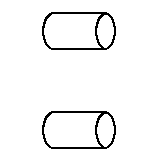Roman ring
Ingeneral relativity,aRoman ring(proposed byMatt Visserin 1997[1]and named after theRoman arch,a concept proposed byMike MorrisandKip Thornein 1988 and named after physicistTom Roman)[2]is a configuration ofwormholeswhere no subset of wormholes is near tochronology violation,though the combined system can be arbitrarily close to chronology violation.
Examples[edit]
For example, anEarth–Moonwormhole whose far end is 0.5 seconds in the "past"will not violatecausality,sinceinformationsent to the far end via the wormhole and back through normal space will still arrive back on Earth (-0.5 + 1) = 0.5 seconds after it was transmitted; but an additional wormhole in the other direction will allow information to arrive back on Earth 1 secondbeforeit was transmitted (time travel). However, it is believed that relative time between the transmission of the information in one wormhole throat and out of the other end in a ring structure will remain the same, because light wouldn't have violated local proper time, because the distance traveled by the information would take time, either by going the long way or through the wormhole.
Chronology protection[edit]
Semiclassicalapproaches to incorporating quantum effects into general relativity seem to show that thechronology protection conjecturepostulated by physicistStephen Hawkingfails to prevent the formation of such rings, althoughMatt Visserfeels that there are reasons to think the semiclassical approach is unreliable here, and that a full theory ofquantum gravitywill likely uphold chronology protection.
Gallery[edit]



Notes[edit]
- ^Visser, Matt (1997). "Traversable wormholes: the Roman ring".Physical Review D.55(8): 5212–5214.arXiv:gr-qc/9702043.Bibcode:1997PhRvD..55.5212V.doi:10.1103/PhysRevD.55.5212.S2CID2869291.
- ^Morris M. S., Thorne K. S. (1988)."Wormholes in spacetime and their use for interstellar travel: A tool for teaching general relativity".Am. J. Phys.56(5): 395.Bibcode:1988AmJPh..56..395M.doi:10.1119/1.15620.
References[edit]
- Visser, Matt (1994). "van Vleck determinants: traversable wormhole spacetimes".Physical Review D.49(8): 3963–3980.arXiv:gr-qc/9311026.Bibcode:1994PhRvD..49.3963V.doi:10.1103/PhysRevD.49.3963.PMID10017400.S2CID38145051.
